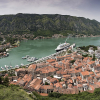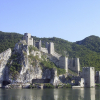
Stećak
Stećak (Serbian Cyrillic: Стећак, pronounced [stěːtɕak]) or Stećci in plural form (Serbian Cyrillic: Стећци, pronounced [stěːtɕtsi]) is the name for monumental medieval tombstones, that lie scattered across Bosnia and Herzegovina, and the border parts of Croatia, Montenegro and Serbia. An estimated 60,000 are found within the borders of modern Bosnia and Herzegovina and the rest of 10,000 are found in what are today Croatia (4,400), Montenegro (3,500), and Serbia (2,100), at more than 3,300 odd sites with over 90% in poor condition.
Appearing in the mid 12th century, with the first phase in the 13th century, the custom of cutting and using stećci tombstones reached its peak in the 14th and 15th century, before being discontinued in the very early 16th century during the Ottoman conquest of Bosnia and Herzegovina. They were a common tradition amongst Bosnian, Catholic and Orthodox Church followers alike, and were used by both Slavic and the Vlach populations.
Stećci are inscribed on the World Heritage List by UNESCO since 2016, with a selection of some 4,000 individual monoliths, grouped in necropolises at 28 locations, of which 22 in Bosnia and Herzegovina, two in Croatia, three in Montenegro, and three in Serbia. The one of the best preserved collection of these tombstones is Radimlja, west of Stolac in Bosnia and Herzegovina.







